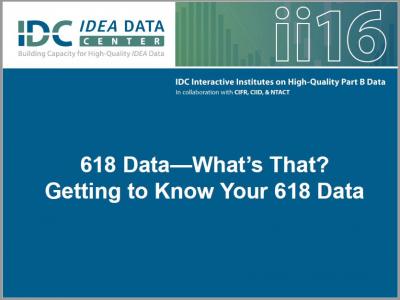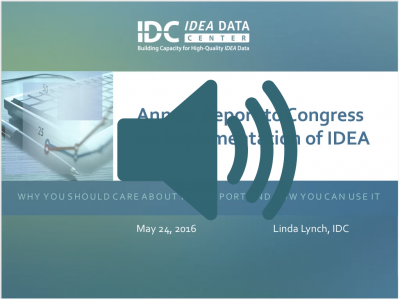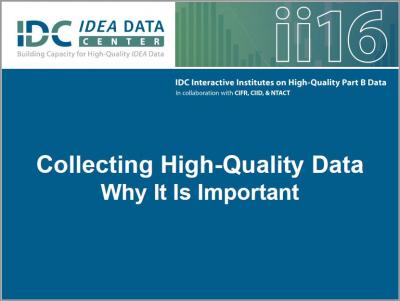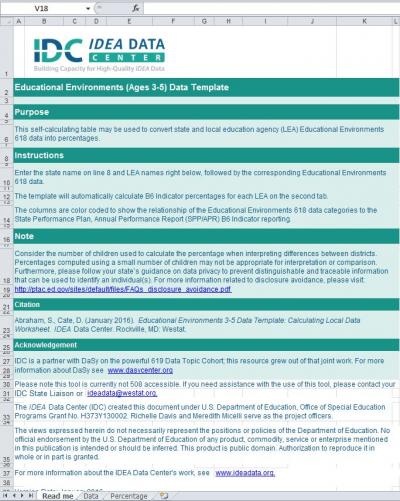Archived Resources
The Resource Library houses tools and products that were developed by IDC, developed with its collaborators, or submitted by IDC stakeholders. Search and filtering tools are available to help users navigate through the library.
Archived Resources 1 - 7 of 24
Format: Presentations
618 Data—What’s That? Getting to Know Your 618 DataHave you heard these terms 618, 616, EDFacts, EMAPS, file specifications, OMB-MAX, GRADS360, Data Quality Reports? Do you understand what they are referencing? Do you want to gain a higher knowledge of these terms? Participants in this presentation learned more about IDEA data reporting requirements in relation to the 618 data collections. They also learned about data quality considerations and tools states can use when going through the data collecting and reporting procedures.
Format: Recordings
Annual Report to Congress on Implementation of IDEA WebinarThe webinar featured the purpose and history of the Annual Report to Congress on the Implementation of the Individuals with Disabilities Education Act, its current organization and content, links to the report and its data sources, and suggestions for how participants can use the report. The webinar was designed so that participants would have a greater understanding of why it is important to work to improve the quality of IDEA-related data by seeing how the U.S. Department of Education uses IDEA data to meet an annual statutory requirement to report to Congress;. In addition, it was designed to help participants become familiar with a key resource on state and national IDEA data and related information and prompt them to think about how they might use the resource.
Format: Guides, Papers, and Reports
CEIS Practice GuideThe CEIS Practice Guide provides two scenarios each for voluntary CEIS and comprehensive CEIS. Each scenario describes an LEA’s implementation of voluntary or comprehensive CEIS and how the LEA or state could track the amount LEAs reserved for voluntary or comprehensive CEIS, the activities conducted using IDEA funds for voluntary or comprehensive CEIS, the target group of students, and ongoing student-level data about special education services. IDC and CIFR collaborated to develop the practice guide.
Format: Presentations
Collecting High-Quality Data: Why It Is ImportantThis presentation focused on what is meant by the term “data quality” and provided information regarding the importance of high-quality data in the collection, reporting, and use of data in local and state decision making. Presenters shared actual examples from state experiences.
Format: Presentations
Data Mining Section 618 Data to Prepare the APRThe required measurements for APR Indicators B3, B4, B5, B6, B9, and B10 (the assessment, discipline, LRE, and disproportionality indicators) are based on Section 618 data. This session focused on selected section 618 data submissions and how the data can be explored to provide more in-depth information for use in discussion with state’s APR stakeholders. Presenters demonstrated some practical methods for taking a deeper look at data in the IDEA EDFacts file submissions using readily available data analysis tools (Microsoft Excel).
Format: Toolkits and Templates
Educational Environments 3-5 Data Template: Calculating Local Data WorksheetThis data template provides SEAs and LEAs the opportunity to see in real-time the percentages of their children ages 3-5 attending and receiving services in specific educational environments. When the LEA 618 educational environments data is simply entered on the data tab, the percentages will be calculated and displayed on the percentage tab. The use of this tool will allow SEAs to compare the percentages of children within educational environments across LEAs.
Format: Presentations
Equity, Inclusion, and Opportunity: Creating Educational Systems That Meet the Needs of All Groups of StudentsMany schools and districts have been identified as low performing or disproportionate because of disparities between subgroups on a variety of success measures. Other schools and districts are proactively trying to address identified success gaps. Presenters from IDC demonstrated IDC's Success Gaps Toolkit that can help schools and districts 1) prepare all of their students for success in college and careers by addressing success gaps, 2) collect and use quantitative and qualitative data for the purpose of root-cause analysis of those success gaps, and 3) focus attention on those root causes for the benefit of children and students in the lowest performing subgroups.








